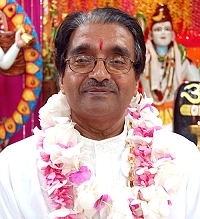From a yagya with Paramacharya of SWAHA, H.H. Pundit Hardeo Persad
In the sacred verses of the Maha Shiva Puraana, a profound epic unfolds as the sages, seeking enlightenment, ask Shri Sutaji to elucidate the origins and profound significance of the Harishwar Shiv Lingam. In response, the divine narrative weaves a tale of cosmic struggle, divine worship and ultimate self-sacrifice that unveils the interconnectedness of divine forces.
As cyclically occurs from age to age, a negative era enveloped the cosmos as demonic forces wielded unprecedented power, causing havoc and overshadowing righteousness. In this tumultuous time, the celestial protectors themselves were victims of the influences of negativity, and the very fabric of dharma began to unravel. Dharma, the innermost constitution guiding one’s life, is fulfilled through the conscientious discharge of duties and responsibilities in various societal roles.
Shri Sutaji encourages us to introspect, urging us to emulate the examples set by divine incarnations like Shri Raam, who epitomises the virtues of a son, husband and leader. In the pursuit of maintaining dharma, the message is clear – work is worship, and duty is akin to serving the divine.
In the celestial realm, distress led the Devas to seek divine intervention, turning to Lord Vishnu, the sustaining power in creation. Recognizing the gravity of the situation, Vishnu Bhagavan embarked on a sacred journey to Kailash Parvat, preparing to invoke the presence of Bhagwan Shankar through Shiv puja.
The ensuing tale unfolds as Vishnu Bhagavan, with unwavering devotion, performs a thousand name chant, the Shiva Sahasranaam stotra, offering a lotus flower at each invocation. His steadfast commitment is tested when, at the last offering, Bhagavan Shankar tests his devotion by taking away the final lotus flower. In an act of unparalleled sacrifice, Vishnu Bhagavan offers his own eye to fulfil the ritual, demonstrating dispassionate devotion.
The divine response is swift, as Shivaji appears and, pleased with Vishnu’s devotion, grants him the Sudarshan Chakra. This emblem, constantly spinning on Vishnu’s index finger, becomes the instrument to dismantle the forces of evil, symbolising the victory of righteousness.
The narrative transcends mere symbolism, delving into the profound metaphysical realm. The sacrifice of an eye represents the journey from duality to non-duality, where Vishnu Bhagavan and Bhagavan Shiva become indistinguishable essences residing within each other. If we go within ourselves, all the powers exist inside of us. Both forms of the Lord are the same infinite, however they represent different divine functions. Vishnu Bhagavan represents sattvic prakriti, He is Brahm identifying with sattwa (righteousness, purity). He sustains everything in creation. Shivaji, the divinity identifying with tamas prakriti or the undifferentiated state of being, disperses everything back to its original state. Both are facets of the one Brahm, with different functions.
The 1,000 names of Lord Shiva and the offering of lotus flowers represent the blossoming of the crown chakra, the sahasrara chakra, signifying the pinnacle of spiritual enlightenment. The Sudarshan Chakra, symbolic of time’s cyclical nature, serves as a constant reminder of our entanglement in the cosmic dance. Its elliptical motion around Bhagavan Vishnu’s index finger is akin to the elliptical dance of planets around the sun.
Harishwar Lingam stands as a testament to divine grace, sacrifice and the eternal dance of the cosmos, urging seekers to embark on an internal journey towards the highest realms of spiritual awakening.



